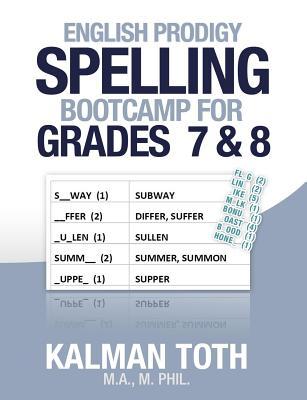
Book
English Prodigy Spelling Bootcamp For Grades 7 & 8
(Write a Review)
Paperback
$19.95
Learning to Spell
When we talk about learning how to spell, we are referring to learning the correct written representation of our language. Many skills are not only possible but also desirable for students to learn on their own. However, an accurate representation of our written language is not one of them. Most spelling follows expected patterns. Acquiring knowledge of spelling patterns helps a student develop a foundation for spelling success and strengthens spelling skills. The student needs to learn and practice the common spelling patterns used in English. Doing so will help them achieve spelling success. Not only knowing the patterns of letters but also the expected frequency of occurrence helps children improve spelling accuracy. They also need to learn what spelling pattern is used for a specific word. Learning to spell is both conceptual and associative; children must learn concepts about language structure at several levels and remember specific letter sequences. Teachers need to help students recognize spelling patterns. In addition, when they teach spelling patterns, they need to use everyday words. The puzzles in this book teach and reinforce spelling patterns using everyday words.
Middle-Grade Spelling
Although less is known about the nature and the sequence of stages in spelling development in the middle grades, students do continue to develop their concepts of orthography and their ability to associate spelling patterns with speech patterns. As they learn more words and store more examples of common spelling patterns in their memory, they rely increasingly on analogy strategies to spell. They learn new words, as they are associated in memory with words that share similar patterns. Rather than relegate spelling to a back burner during the middle school years, spelling can and should be an integral part of language instruction. Instruction in spelling helps students master the basics of the English language, especially students who may struggle with reading. Teaching spelling enables a struggling student to use different senses. Thus, it helps the student learn and master the relationship between the sounds and symbols of our language, the backbone of reading.
It is not only the struggling student who benefits from learning spelling skills but also the proficient students, who will be able to more deeply understand the patterns of our complex language and become master communicators.
Live Life Active, Bright, Healthy & Happy!
Learning to Spell
When we talk about learning how to spell, we are referring to learning the correct written representation of our language. Many skills are not only possible but also desirable for students to learn on their own. However, an accurate representation of our written language is not one of them. Most spelling follows expected patterns. Acquiring knowledge of spelling patterns helps a student develop a foundation for spelling success and strengthens spelling skills. The student needs to learn and practice the common spelling patterns used in English. Doing so will help them achieve spelling success. Not only knowing the patterns of letters but also the expected frequency of occurrence helps children improve spelling accuracy. They also need to learn what spelling pattern is used for a specific word. Learning to spell is both conceptual and associative; children must learn concepts about language structure at several levels and remember specific letter sequences. Teachers need to help students recognize spelling patterns. In addition, when they teach spelling patterns, they need to use everyday words. The puzzles in this book teach and reinforce spelling patterns using everyday words.
Middle-Grade Spelling
Although less is known about the nature and the sequence of stages in spelling development in the middle grades, students do continue to develop their concepts of orthography and their ability to associate spelling patterns with speech patterns. As they learn more words and store more examples of common spelling patterns in their memory, they rely increasingly on analogy strategies to spell. They learn new words, as they are associated in memory with words that share similar patterns. Rather than relegate spelling to a back burner during the middle school years, spelling can and should be an integral part of language instruction. Instruction in spelling helps students master the basics of the English language, especially students who may struggle with reading. Teaching spelling enables a struggling student to use different senses. Thus, it helps the student learn and master the relationship between the sounds and symbols of our language, the backbone of reading.
It is not only the struggling student who benefits from learning spelling skills but also the proficient students, who will be able to more deeply understand the patterns of our complex language and become master communicators.
Live Life Active, Bright, Healthy & Happy!
Paperback
$19.95